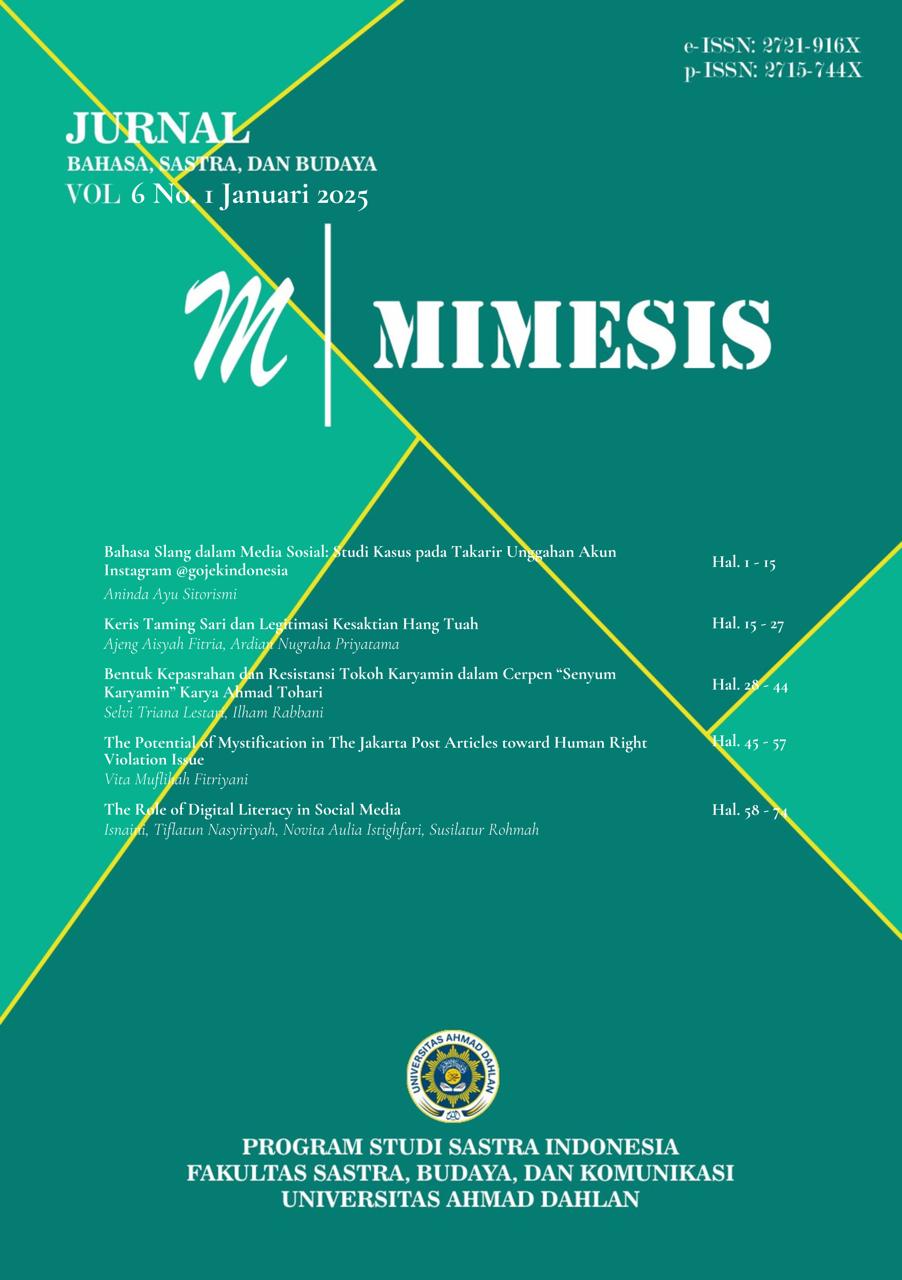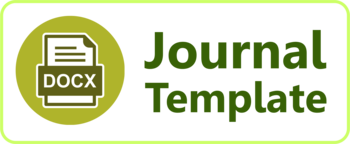The Role of Digital Literacy in Social Media
DOI:
https://doi.org/10.12928/mms.v6i1.12242Keywords:
Digital literacy, Hoaxes, Social Media, Post-truth eraAbstract
The increasing spread of false information (hoaxes) in the post-truth era highlights the urgent need to enhance digital literacy. Digital literacy aims to empower audiences to critically interpret the vast array of messages circulating in digital media. This study explores the significance of digital literacy, its impact, and strategies for improving digital literacy skills to combat hoaxes. This research employs a library research method with a descriptive qualitative approach, analyzing a variety of relevant literature, including journals, books, and reports. The study focuses on the evolving media ecology and introduces novel insights into digital literacy, particularly in the Indonesian context. Findings reveal that the low level of digital literacy in Indonesia evidenced by a limited ability to critically analyze information contributes significantly to the widespread dissemination of hoaxes via social media. The study identifies five essential components of digital literacy: technical proficiency, critical thinking, visual literacy, social awareness, and adaptive skills. These components play a crucial role in enabling users to detect fake news, verify information, and minimize misinformation. Moreover, the research highlights the role of digital literacy as a sustainable solution for reducing hoaxes by fostering self-regulation and informed behavior. Recommendations include integrating digital literacy into educational curricula, conducting public awareness campaigns, and encouraging collaborative efforts between government and technology platforms. By addressing these challenges, this study contributes to a deeper understanding of digital literacy as a vital tool for navigating the complexities of the digital age and fostering a more informed society.
References
Alda, R., Boholano, H., & Dayagbil, F. (2020). Teacher education institutions in the philippines towards education 4.0. International Journal of Learning, Teaching and Educational Research, 19(8). https://doi.org/10.26803/ijlter.19.8.8
Apuke, O. D. (2023). Literacy Concepts as an Intervention Strategy for Improving Fake News Knowledge, Detection Skills, and Curtailing the Tendency to Share Fake News in Nigeria. Child and Youth Services, 44(1), 88–103. https://doi.org/10.1080/0145935X.2021.2024758
Arafah, B. (2023). The Digital Culture Literacy of Generation Z Netizens as Readers, Producers and Publishers of Text on Social Media. International Journal of Intelligent Systems and Applications in Engineering, 11(3), 112–123. Retrieved from https://www.scopus.com/inward/record.uri?partnerID=HzOxMe3b&scp=85175144527&origin=inward
Arham, S. (2022). Peserta didik ramah digital dalam mencegah perundungan, kekerasan seksual, dan intoleransi. repositori.kemdikbud.go.id. Retrieved from https://repositori.kemdikbud.go.id/29930/
Assyakurrohim, D., Ikhram, D., Sirodj, R. A., & Afgani, M. W. (2022). Case Study Method in Qualitative Research. Jurnal Pendidikan Sains Dan Komputer, 3(01), 1–9.
Balt, E. (2023). Social media use of adolescents who died by suicide: lessons from a psychological autopsy study. Child and Adolescent Psychiatry and Mental Health, 17(1). https://doi.org/10.1186/s13034-023-00597-9
Center, K. I. (2020). Status Literasi Digital Indonesia: Survei di 34 Propinsi. Jakarta: Katadata Insight Center.
Chase, Z., & Laufenberg, D. (2011). Embracing the squishiness of digital literacy. Adolescent &Adult Literacy. https://doi.org/10.1598/JAAL.54.7.7
Cinelli, M., & Morales, G. D. F. (2021). The echo chamber effect on social media. Proceedings. https://doi.org/10.1073/pnas.2023301118
Cong, J., Ahmad, Z., Alsaedi, B. S. O., Alamri, O. A., Alkhairy, I., & Alsuhabi, H. (2021). The Role of Twitter Medium in Business with Regression Analysis and Statistical Modelling. Computational Intelligence and Neuroscience, 2021. https://doi.org/10.1155/2021/1346994
Dewi, C. A. (2021). The Urgency of Digital Literacy for Generation Z Students in Chemistry Learning. International Journal of Emerging Technologies in Learning, 16(11), 88–103. https://doi.org/10.3991/ijet.v16i11.19871
Domenico, G. Di, Sit, J., Ishizaka, A., & Nunan, D. (2021). Fake news, social media and marketing: A systematic review. Journal of Business Research. Retrieved from https://www.sciencedirect.com/science/article/pii/S0148296320307852
Fadli, M. R. (2021). Memahami desain metode penelitian kualitatif. HUMANIKA, 21(1). https://doi.org/10.21831/hum.v21i1.38075
Gautam, V. S., Katiyar, S., & Sharma, K. (2023). Social Media Fake News Detection Using Machine Learning. 2023 5th International Retrieved from https://ieeexplore.ieee.org/abstract/document/10541571/
Given, L. (2012). The SAGE Encyclopedia of Qualitative Research Methods. In The SAGE Encyclopedia of Qualitative Research Methods. https://doi.org/10.4135/9781412963909
Guess, A. M., & Munger, K. (2023). Digital literacy and online political behavior. Political Science Research and Methods. Retrieved from https://www.cambridge.org/core/journals/political-science-research-and-methods/article/digital-literacy-and-online-political-behavior/941391F2B600ED4543CF5586F19AE16E
Gunadi, R. A. A., & Lubis, M. (2023). The Effect of Digital Literacy on Children Violence. 1st UM Surabaya Multidisciplinary. Retrieved from https://www.atlantis-press.com/proceedings/micon-21/125986622
Hastoto, S. M., & Irhandayaningsih, A. (2024). Kemampuan Literasi Digital Guru SD Negeri Kriwen 01 dalam Pembelajaran Daring pada Masa Pandemi Covid-19. Anuva. Retrieved from https://ejournal2.undip.ac.id/index.php/anuva/article/view/15971
Informasi, K. K. dan. (2022). Status literasi digital di Indonesia. Katadata Insight Center.
Jones, R. H., & Hafner, C. A. (2021). Understanding Digital Literacies: A Practical Introduction. In Understanding Digital Literacies: A Practical Introduction. https://doi.org/10.4324/9781003177647
Keyes, R. (2004). The post-truth era: Dishonesty and deception in contemporary life. Macmillan.
Kominfo, R. I., & Center, K. I. (2020). Laporan Survei Literasi Digital Indonesia 2020. Katadata Insight Center (Issue November).
Kunmei, L., Indira, D., Soeria Soemantri, Y., & Lupi Ardiati, R. (2022). Analisis Semiotika Pierce: Perbandingan Poster Iklan Sampo Di Tiongkok Dan Indonesia. MIMESIS, 3(1), 58–74. https://doi.org/10.12928/mms.v3i1.5560
Kurniasih, E., & Damayani, N. A. (2024). The Role of Information Literacy in Mitigating the Spread of Hoaxes on Social Media. Khizanah Al-Hikmah. Retrieved from https://journal.uin-alauddin.ac.id/index.php/khizanah-al-hikmah/article/view/45343
Lanham, R. A. (1995). Digital literacy. Scientific American. elibrary.ru. Retrieved from https://elibrary.ru/item.asp?id=2430051
López-González, H., Sosa, L., & Sánchez, L. (2023). Media and Information Literacy and Critical Thinking: A Systematic Review. Revista Latina. Retrieved from https://search.proquest.com/openview/c7cb79c4b2ebee9f3bf0e37263abcc93/1?pq-origsite=gscholar&cbl=236244
Mahendra, Y., Jundi, R., & Wulandari, G. (2024). The Urgency of Digital Literacy in Shaping Students’ Civic Virtue: Challenges and Opportunities in the Technological Era. ICoCSE. Retrieved from https://jurnal.untirta.ac.id/index.php/ICoCSE/article/view/29986
Maisaroh, S. (2023). Pengembangan Modul Dengan Qr Code Materi Eksplorasi Negara-Negara Asean Sebagai Sumber Belajar Ips. Social Studies. Retrieved from https://journal.student.uny.ac.id/index.php/social-studies/article/view/18093
Mokhtar, N., Xuan, L. Z., & Lokman, H. F. (2023). Theory, literature review, and fun learning method effectiveness in teaching and learning. International Journal. ijssers.org. Retrieved from https://ijssers.org/wp-content/uploads/2023/08/30-2508-2023.pdf
Muhamad, N. (2024). Ada 12.547 Konten Hoaks Selama 5 Tahun Terakhir, Terbanyak Isu Kesehatan. Retrieved January 12, 2025, from databoks.katadata.co.id website: https://databoks.katadata.co.id/teknologi-telekomunikasi/statistik/78151e2624ead29/ada-12547-konten-hoaks-selama-5-tahun-terakhir-terbanyak-isu-kesehatan?utm_source=chatgpt.com
Nisa, K. (2024). Peran Literasi di Era Digital Dalam Menghadapi Hoaks dan Disinformasi di Media Sosial. Impressive: Journal of Education. Retrieved from https://journal.satriajaya.com/index.php/ijoe/article/view/75
Novitasari, S. I., Natalia, T. L., & Pebrianto, T. (2023). Digital Literacy Inherency within Narratives Subject at SMP Kristen Palangka Raya. Scientific Research. Retrieved from https://jsret.knpub.com/index.php/jrest/article/view/138
Nurhaeni, I. D. A., Kurniawan, Y., Nugroho, R. A., & Putri, I. I. (2022). Information and Communication Technology-Facilitated Sexual Violence (ICTFSV) on Adolescents: Experience in Indonesia. Society. Retrieved from https://societyfisipubb.id/index.php/society/article/view/288
Pertiwi, I. S. K., & Lestari, M. T. (2024). Digital literacy analysis: A case study of Telkom Indonesia in exploring its work environment dynamics. Bricolage: Jurnal Magister. Retrieved from https://journal.ubm.ac.id/index.php/bricolage/article/view/5321
Phippen, A. (2024). Digital Literacy. In D. Baker & L. Ellis (Eds.), Encyclopedia of Libraries, Librarianship, and Information Science (First Edition) (First Edit, pp. 125–132). Oxford: Academic Press. https://doi.org/https://doi.org/10.1016/B978-0-323-95689-5.00097-3
Pillai, R. M., & Fazio, L. K. (2021). The effects of repeating false and misleading information on belief. Wiley Interdisciplinary Reviews: Cognitive. https://doi.org/10.1002/wcs.1573
Potter, C., Lohr, N. J., Ciske, S. J., & Sanders, S. N. (2001). Wisconsin Educational Technology Plan PreK-12: 2000 Addendum. A Supplement Marking Progress and Extending the Vision. ERIC. Retrieved from https://eric.ed.gov/?id=ED453806
Pradana, P. H., Agustini, K., & Dantes, G. R. (2024). The urgency of digital literacy learning in educational units: Systematic literature review. Child Education. Retrieved from https://journal2.unusa.ac.id/index.php/CEJ/article/view/6100
Prasetya, A. B. (2024). Kekerasan Epistemik Selama Covid-19 di Indonesia Angga Trio Sanjaya Dedi Pramono Selama pandemik Covid-19 , 5(2), 97–113.
Pratiwi Agustini. (2023). Indeks Literasi Digital Indonesia Kembali Meningkat Tahun 2022. Retrieved January 12, 2025, from aptika.kominfo.go.id website: https://aptika.kominfo.go.id/2023/02/indeks-literasi-digital-indonesia-kembali-meningkat-tahun-2022/?utm_source=chatgpt.com
Rodricks, S., Dsa, R., & Gupta, R. (2023). Mitigating Social Media Misinformation: An Analysis of Hoax Hunter’s Efficacy in Detecting and Debunking False Information. academia.edu. Retrieved from https://www.academia.edu/download/105619122/IRJET_V10I814.pdf.
Rodrigues, F. (2024). The social media Infodemic of health-related misinformation and technical solutions. Health Policy and Technology, Vol. 13. https://doi.org/10.1016/j.hlpt.2024.100846
Saputra, C. S., Wijaya, N., & Anggreainy, M. S. (2023). Hoax Detection in Social Media: A Literature Review. Data Sciences. Retrieved from https://ieeexplore.ieee.org/abstract/document/10284605/
Serrano-Puche, J. (2021). Digital disinformation and emotions: exploring the social risks of affective polarization. International Review of Sociology, 31(2), 231–245. https://doi.org/10.1080/03906701.2021.1947953
Singh, R. (2024). Social Media Fake News Detection Challenge and Impact for Society. Library Progress International. Retrieved from https://bpasjournals.com/library-science/index.php/journal/article/view/1792
Srivastava, S., Pandey, V. K., Fatima, A., & Pandey, S. (2024). A literature review on process intensification: An innovative and sustainable food processing method. Applied Food. Elsevier. Retrieved from https://www.sciencedirect.com/science/article/pii/S2772502223001002
Tandoc, E. C. (2020). Tools of disinformation: How fake news gets to deceive. Disinformation and Fake News. https://doi.org/10.1007/978-981-15-5876-4_3
Vosoughi, S., Roy, D., & Aral, S. (2018). The spread of true and false news online. Science. https://doi.org/10.1126/science.aap9559
Wahyuni, W. (2023). Literasi Media dalam Meningkatkan Kemampuan Menganalisis Berita Palsu Pada Media Sosial. repository.iainpare.ac.id. Retrieved from https://repository.iainpare.ac.id/id/eprint/7277/
Widodo, K. Y., Endrawati, L., & Sulistio, F. (2022). The Effectiveness of Imprisonment as a Criminal Sanction for Non-Physical Sexual Harassment. International Journal of Social. Retrieved from https://www.ijssrr.com/journal/article/view/544
Yates, K. K. (2024). Impact of Hurricane Irma on coral reef sediment redistribution at Looe Key Reef, Florida, USA. Ocean Science, 20(3), 661–688. https://doi.org/10.5194/os-20-661-2024
Zulaikha, S., & Firmonasari, A. (2023). Wacana Stigmatisasi Perempuan Berpendidikan Tinggi yang Terefleksikan Melalui Media Sosial YouTube. MIMESIS, 4(2), 191–201. https://doi.org/10.12928/mms.v4i2.8623
Downloads
Published
Issue
Section
License
Copyright (c) 2025 Isnaini, Tiflatun Nasyiriyah, Novita Aulia Istighfari, Susilatur Rohmah

This work is licensed under a Creative Commons Attribution-ShareAlike 4.0 International License.
License and Copyright Agreement
In submitting the manuscript to the journal, the authors certify that:
- They are authorized by their co-authors to enter into these arrangements.
- The work described has not been formally published before, except in the form of an abstract or as part of a published lecture, review, thesis, or overlay journal.
- That it is not under consideration for publication elsewhere,
- That its publication has been approved by all the author(s) and by the responsible authorities tacitly or explicitly of the institutes where the work has been carried out.
- They secure the right to reproduce any material that has already been published or copyrighted elsewhere.
- They agree to the following license and copyright agreement.
Copyright
Authors who publish with Mimesis agree to the following terms:
- Authors retain copyright and grant the journal right of first publication with the work simultaneously licensed under a Creative Commons Attribution License (CC BY-SA 4.0) that allows others to share the work with an acknowledgment of the work's authorship and initial publication in this journal.
- Authors are able to enter into separate, additional contractual arrangements for the non-exclusive distribution of the journal's published version of the work (e.g., post it to an institutional repository or publish it in a book), with an acknowledgment of its initial publication in this journal.
- Authors are permitted and encouraged to post their work online (e.g., in institutional repositories or on their website) prior to and during the submission process, as it can lead to productive exchanges, as well as earlier and greater citation of published work.











